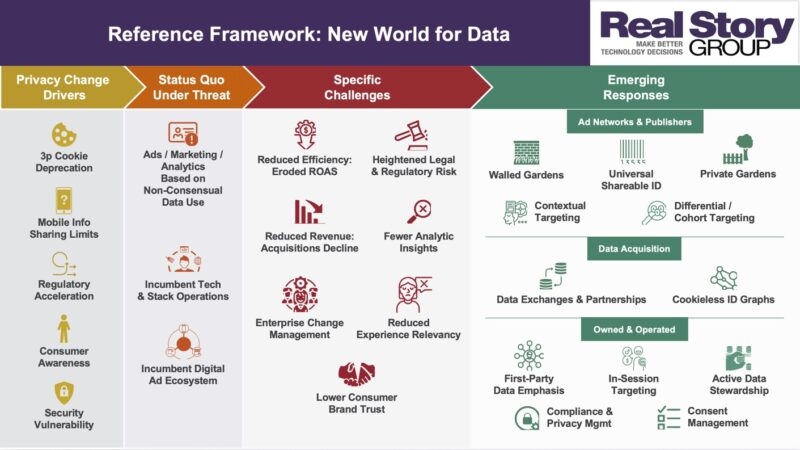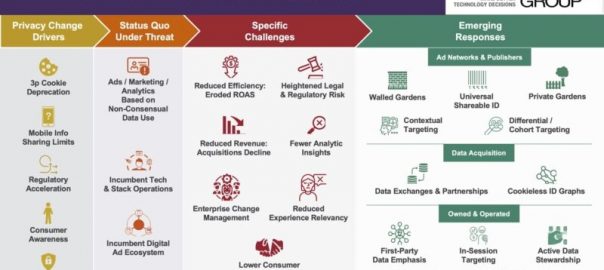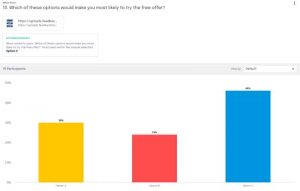Start with an organizing framework to categorize and understand the issues, dynamics, challenges, and opportunities in such a way that you can take action.
Marketers and advertisers are facing choppy waters at the confluence of two powerful currents: a vigorous new era of consumer data privacy, rolling into “data-driven everything” practices like personalization and programmatic advertising — both now turbo-charged by artificial intelligence and machine learning.
The increasing pace of privacy legislation, privacy-protecting tools and advocacy, and the market-shaking actions by Apple and Google to limit cross-device and cross-site tracking have left all parties scrambling for secure footing. Vendors vie for position with new and updated solutions and alliances in a race for adoption — even as the course continues to shift.
With everything in flux, as a marketing leader you might be tempted to crawl under your desk and wait for the dust to settle. Where to begin? Indeed, how to begin when everything is so fluid?
Start with a framework
When faced with a chaotic and unsettled situation, a good place to start is with an organizing framework to categorize and understand the issues, dynamics, challenges, and opportunities in such a way that you can take action.
Given all those cross-cutting currents, at Real Story Group we decided to apply a change-and-adaptation model. We’re calling the resulting reference framework “New World for Consumer Data.” A complete report is available to RSG subscribers, but I’ll summarize the findings here.

Privacy change drivers
Color-coded in gold, these five factors are catalyzing big shifts in the data landscape.
Third-party cookie deprecation
If you think of the advertising and marketing ecosystem as a Jenga tower, Google’s announcement that it intends to withdraw support for third-party cookies in its market-dominating Chrome browser is the move that set the entire structure atremble. Programmatic digital advertising has long relied on third-party cookies to enable real-time bidding, auctioning the attention of web page visitors to advertisers looking for particular audiences.
Mobile information sharing limits
Apple got the ball rolling by giving its mobile device users more control over data they share with the applications they use. Google’s Android is following Apple’s lead, albeit at a slower pace and less aggressively.
Regulatory acceleration
Europe’s General Data Protection Regulation (GDPR) broke the ice, taking effect in 2018. Similar regulations have been and are rolling out around the world, most recently in China. Here in the U.S., we face a state-by-state patchwork of regulations, with California’s CCPA taking effect this year — to be followed in 2023 by CPRA, Virginia’s CDPA, and Colorado’s Privacy Act.
Consumer awareness
Surveys reveal a public that is increasingly sensitive to the visibility of their online activity and the vulnerability of their data. Defensive services like ad blockers, privacy browsers, privacy search engines, and burner emails are proliferating to meet the demand.
Security vulnerability
Data breaches are increasing in frequency and scale at enormous cost to both organizations and the individuals affected.
Specific challenges
The report maps each Privacy Change Driver to a subset of the seven Specific Challenges (denoted in red in the diagram above).
For example, by limiting access to perishable, proximate identifiers used to match ads and marketing to users—and to measure the effectiveness of such efforts— three Specific Challenges arise:
- Reduced Efficiency: Eroded ROAS – The ability to buy media centrally, programmatically, and with surgical user-level targeting has been credited with more efficient ad spending.
- Reduced Revenue: Acquisitions Decline – Reduced ability to fine-tune ad placement and messaging.
- Fewer Analytic Insights – Data-driven analysis informs an array of business decisions; loss of such data may well ripple through the entire enterprise.
Emerging responses
RSG’s report digs into twelve emerging responses, evaluating each three ways:
- Marketer Pros and Cons
- Readiness for adoption by advertisers and marketers on a scale from low to high
- Scoring for how well it addresses each specific challenge on a scale of 0 to 4
Here’s a short summary of those twelve, and what role each potentially plays.
Walled gardens
Already dominating digital ad spend in the U.S., Google, Facebook, and Amazon may grow their share as advertisers and marketers addressable audiences at scale.
Private gardens
Retailers and media with monetizable first-party data are building out their own closed advertising ecosystems.
Universal shareable IDs
Multiple candidates (80+) vie to replace the third-party cookie and grease the wheels of programmatic advertising. It’s a crowded field, very much in flux, and the utility of any one ID will largely hinge on broad adoption.
Differential privacy/cohort targeting
This refers to the fluid and experimental methods being explored to somehow enable both ad-supported media and consumer privacy. Google’s Privacy Sandbox includes a number of proposals, most notably FLoC, which is still evolving under plenty of scrutiny.
Contextual targeting
This legacy method may experience a renaissance not only because of third-party data deprecation but because new technologies like artificial intelligence and machine learning promise a more effective, more automated iteration of the approach.
Data exchanges and partnerships
Cleanroom technologies and services promise to enable the chaste sharing of pseudonymized data (or data attributes and models) among business partners and within exchanges. The technologies may be simpler to untangle here than the questions around consent.
Cookieless ID graphs
There are plenty of other signals aside from 3p cookies that, when combined with machine learning models trained on determined identities, can suss out probabilistic identities. Remember the meme, “on the internet, nobody knows you’re a dog”? Now they do.
First-party data emphasis
When DTC (direct-to-consumer) first popped up as a phenomenon, eating into the revenues of more traditional through-channel incumbents, the value of a direct customer relationship and attendant first-party data came into sharp relief. Add on the deprecation of third-party data and businesses of all types are either undertaking or considering a purposeful effort to directly collect data (and consent to use it) from their customers. Using that information to reach and acquire net new customers is another matter.
In-session targeting
Adjust visitor experiences on your web properties based on real-time, in-session user behavior.
Active stewardship
Take a leading position with proactive policies and practices to safeguard your customers’ data. First movers may win a competitive advantage.
Privacy/compliance management
A growing pool of privacy tech vendors promise services and automation to help manage the increasingly complex array of regulations.
Consent management
Whether sold as part of a broader compliance suite or as a stand-alone, the execution of such tools is key. Heavy-handed or too-clever approaches may not only confuse consumers but also cause brand damage.
That’s a lot of choices …
Does that seem like a lot of responses to you? Well it is, and you should recall your myriad options when vendors coming calling with a single magic bullet — – because there aren’t any. The key then is to focus on fit for your particular circumstances. Each enterprise will need to ground its decisions in a solid understanding of its own brand, risk tolerance, philosophy, and so on.
Read next: Google’s FLoC poses a threat to identity resolution and advertisers.
Take for example “First-Party Data Emphasis,” a seemingly uncontroversial response. Yet there is much to consider, such as the associated data management effort and risk that increases proportionately with a growing trove of customer data. You’ll need to address questions around whether to share that data, for what purpose, with whom and how. Not to mention consent and compliance. For some organizations, a focus on data minimization might be a preferred approach. Or maybe first-party data emphasis is governed by specific standards and guided by a philosophy of collect-only-what-adds-customer-value data minimization.
What you should do
RSG’s report offers several recommendations, and I’ll share two here.
First, benchmark. Do the analysis to estimate, for example, the effect Google’s cutting third-party cookie support on Chrome will have on your media spend and its contribution to sales. A good understanding of the potential impact will help inform your planning to meet the challenge — and help feed any associated business case.
Second, consider pulling together a cross-functional team, ideally with executive sponsorship. This is a complex and high-stakes set of issues that invite a shared organizational approach that includes voices from legal, privacy/compliance, security, data, and tech — as well as marketing. Regardless of how your company ultimately decides to proceed, a holistic approach means more perspective, more information, and broader awareness.
What comes next
This is a fast-moving environment, so I’ve found it pays to monitor signals from larger enterprises and the marketplace as a whole. Look for more in these pages as we share what we learn.
Real Story on MarTech is presented through a partnership between MarTech and Real Story Group, a vendor-agnostic research and advisory organization that helps organizations make purchasing decisions on marketing technology applications and digital workplace tools.
The post The Real Story on MarTech: Navigating the new world of consumer privacy appeared first on MarTech.
(37)








